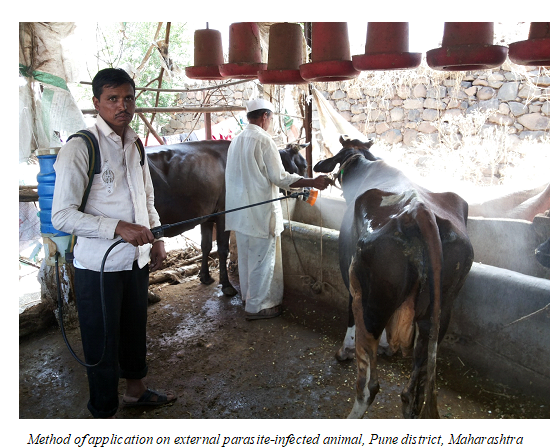A formulation consisting of herbal ingredients like Neem (Azadirachta indica) and Nagod (Vitex negundo) has been found to be effective in combatting tick infestation among dairy animals.
Farmers who depend on dairy animal production are compounded by livestock ailments like tick infestation. These external parasites are found widely in cattle sheds across all geographical regions and proliferate rapidly. This causes tick worry, loss of appetite among animals causing reduction in milk production, thereby lessening farmers’ income. These parasites are vectors of systemic protozoan infection, threat to dairy animal health & productivity.
Presently, farmers rely on chemical acaricides that are costly, have to use recurrently due to nature of parasites. This raises input costs, and seldom farmers, particularly small, marginal farmers, get rid of this vicious cycle of seeking chemical acaricide.

Responding to the urgent requirement to develop suitable intervention measures in combating external parasites and to reduce the input cost, The National Innovation Foundation (NIF) -India, an autonomous body of the Department of Science & Technology, has developed, standardized a formulation comprising common herbal ingredients like Neem (Azadirachta indica) and Nagod (Vitex negundo). These medicinal trees are widely known among indigenous communities, common part of medicinal system in treatment of various ailments.
The formulation is easy to prepare and effective against hard tick infestation and Rhipicephalus (Boophilus) Sp. the etiological parasite in cattle.
Studies conducted at Gandhinagar district, Gujarat, demonstrated efficacy against hard tick infestation. The collaborative activity of NIF with Veterinary College, Palampur Himachal Pradesh held at Kangra district found similar percent efficacy against Rhipicephalus (Boophilus) Sp. the etiological parasite. The interface with Pune Zilha Sahakari Dudh Utpadak Sangh Maryadit, popularly called Katraj Dairy, Pune helped to undertake front line demonstration of farmer-friendly technology at Daund, Shirur, and Purandar taluka’s of Pune district, and capacity-building activities were undertaken. Farmers themselves can develop the formulation at the farm field. The functional efficacy, easy mode of preparation, and known practices assisted farmers to take note of this technology. This helped add value to local health traditions, strengthen inherent abilities, lessen dependence on institutional health systems, and benefit from knowledge system(s).
Subsequently, the dairy union started training dairy farmers to reduce the treatment cost and lessen the risk in reoccurrence of parasites. Maharashtra Animal and Fishery Sciences University, College of Veterinary Science, Palampur, Himachal Pradesh, College of Veterinary Science, Hassan, Karnataka has also recommended this insitu model of alternative technology for scaling up in the respective state.
Formation of suitable partnerships with institutions helped in expanding the availability of technology among dairy farmers in wider region. Demonstrations were held with the support of ICAR- National Dairy Research Institute, Karnal that resulted in systemic evaluation, transfer of knowledge in Haryana. With these efforts, the technology was recommended as package of practice through field evaluation. Paraextension staffs were trained by ICAR-Krishi Vigyan Kendra, Tamil Nadu Veterinary and Animal Sciences University, Kalasamuthiram, Kallakurichi district of Tamil Nadu. The institution had popularized the technology with the support of the Regional Joint Director, Dept of Animal Husbandry, Govt. of Tamil Nadu.

To prepare the formulation, about 2.5 kilogram fresh leaves of neem are collected and kept in 4 litre lukewarm water. Similarly, about one kilogram fresh leaves of nagod is collected and kept in 2 litre lukewarm water. These medicines are kept in lukewarm water for at least an hour. Afterward, the preparation is allowed to cool under normal room temperature overnight. Each preparation's supernatant liquid (crude extract) is collected and stored. These individual crude extracts of neem, nagod have to be mixed in the ratio of 3:1 (Limbada/Neem: Nagod/Monks pepper) as per requirement. This stock solution can be mixed in 3.6 litre of normal water for usage.
NIF’s polyherbal medication was found to demonstrate efficacy in field conditions and the development of technology-based on resources available in front of farm fields. The popularization measures were held with the support of inter-institutional government cooperation for advancing technology to needy farmers.






























